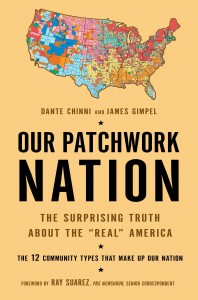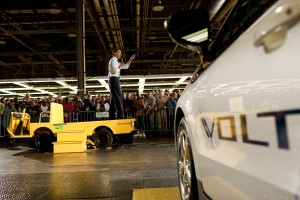In his State of the Union address, President Obama proclaimed, “We bet on American workers. We bet on American ingenuity. And tonight, the American auto industry is back.” President Obama has good reason to be optimistic. Collectively, General Motors, Ford, and Chrysler gained market share against foreign brands for the first time since 1988. GM and Ford earned solid yearly profits, and even Chrysler posted a profit for the first time in years. The domestic auto industry will be the feather in President Obama’s cap during the presidential election as he defends himself against Republican attacks on government bailouts. The recent history of the auto industry has been muddled by politics, and it has become increasingly difficult to uncover the real story. Once Upon a Car: The Fall and Resurrection of America’s Big Three Auto Makers by Bill Vlasic, the Detroit bureau chief for The New York Times, succeeds in putting aside politics and personal vendettas as it tells the real story of the decline and recovery of the American auto industry.
The book begins in 2005. For over a decade, GM, Ford, and Chrysler had dominated the hugely profitable market for large pickup trucks and SUVs. However, the era of cheap gas and easy loans was coming to an end. To make matters worse, the Big Three were slowly being suffocated by crushing health care and pension costs for its hundreds of thousands of current and retired workers. These costs were sustainable in past decades when the Detroit automakers had a majority share of the American auto market, but they could no longer afford to compete with Asian automakers whose non-unionized workers cost $55 an hour instead of the $77 an hour that GM, Ford, and Chrysler were paying in wages and benefits. There was a storm on the horizon that the leaders of GM, Ford, and Chrysler failed to anticipate.
Vlasic is at his best as he details GM and Chrysler’s spiral into bankruptcy and Ford’s fight for its life from the perspective of every group involved in an interwoven and fast-paced narrative. The President of the United Auto Workers Ron Gettelfinger garner’s sympathy as he passionately tries to preserve the way of life enjoyed by hundreds of thousands of factory workers and retirees. Vlasic describes him as “both an idealist and a pragmatist, a true believer waging a holy war and a hardheaded negotiator determined to cut the best possible deal.” Interviews with longtime factory workers as they face the uncertainty of unemployment are particularly moving. Reading about Rebecca Oelfke, a mother of two who supports her kids and disabled husband by working at one of GM’s parts suppliers really injects a human element into the whole tragedy and illuminates how important the Big Three are to the economy of the United States.
 Vlasic’s ability to integrate the perspectives of the many stakeholders sets Once Upon a Car apart from other books about the auto bailouts. Paul Ingrassia’s book Crash Course: The American Automobile Industry’s Road to Bankruptcy and Bailout-and Beyond provides a more extensive analysis of the events and decisions that brought down the Big Three, but Once Upon a Car is written in a more readable, fast-paced manner The book feels like a novel rather than a nonfiction recollection of a recent industrial calamity. In September 2010, Steven Rattner, the car czar, released his own account of the auto bailout in his book Overhaul. It is an interesting account, but it focuses almost exclusively on the government’s role in the bailouts of GM and Chrysler. And unlike Once Upon a Car, it does not really analyze why the Big Three got into their precarious situations.
Vlasic’s ability to integrate the perspectives of the many stakeholders sets Once Upon a Car apart from other books about the auto bailouts. Paul Ingrassia’s book Crash Course: The American Automobile Industry’s Road to Bankruptcy and Bailout-and Beyond provides a more extensive analysis of the events and decisions that brought down the Big Three, but Once Upon a Car is written in a more readable, fast-paced manner The book feels like a novel rather than a nonfiction recollection of a recent industrial calamity. In September 2010, Steven Rattner, the car czar, released his own account of the auto bailout in his book Overhaul. It is an interesting account, but it focuses almost exclusively on the government’s role in the bailouts of GM and Chrysler. And unlike Once Upon a Car, it does not really analyze why the Big Three got into their precarious situations.
GM and Chrysler emerged from bankruptcy court with clean balance sheets and strong future product portfolios. GM got a new CEO and management team, and its situation improved to the point where it was able to have the largest IPO in U.S. history in late 2010. Chrysler was incorporated into the Italian automaker Fiat, where CEO Sergio Marchionne finally added small fuel efficient cars to Chrysler’s lineup. Ford emerged from the crisis better than ever. Alan Mulally had assembled a team of executives who were completely dedicated to continuing Ford’s success. Ford had a range of hot-selling vehicles such as the mid-size Ford Fusion, the compact Ford Focus, and the rugged Ford F-Series trucks which were competitive with the best vehicles that Honda or Toyota had to offer. Times had definitely changed.
Several Republicans, with Mitt Romney being the most notable, have harshly criticized President Obama’s handling of the auto bailouts. In fact, Romney published an op-ed in the Detroit News on February 14, 2012 clarifying his position on the issue.In the editorial, Romney attacks Obama’s decision to provide $85 billion in bailout funds to GM and Chrysler before easing them into accelerated bankruptcy. This claim is not completely true because President Bush approved over $17 billion in bailout funds near the end of his term. He also echoes many Republicans’ criticisms by arguing that the Big Three should have been left to enter bankruptcy with no government intervention.This course of action would have been extremely risky. Hundreds of thousands of jobs would have been lost from the closure of auto dealerships, factories, and parts suppliers. Even more would have been lost when the small business around the closed factories disappeared. In his op-ed, Romney said, “The president tells us that without his intervention, things in Detroit would be worse. I believe that without his intervention things there would be better.” Maybe Romney and the other critics of the auto bailouts are right. It is possible that GM, Chrysler, and Ford could have recovered without government intervention. But considering what was at stake, as Vlasic makes clear, it would have been reckless to leave one of America’s most important industries in such an uncertain condition.
No matter what your opinion on the auto bailouts, there is no escaping the sense of optimism felt at the end of the book. By the start of 2011, GM, Ford, and Chrysler were finally producing cars that could compete against anyone else’s. Like a mythical phoenix, the American auto industry had risen out of the ashes of its near destruction and emerged stronger than ever. Everyone loves a comeback, and after reading Once Upon a Car and watching the recent performance of the Big Three, it is clear that President Obama is right. Detroit is back.
